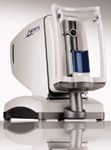New devices help fine tune age-related macular degeneration management
Genetic testing, spectral-domain optical coherence tomography, multispectral digital ophthalmology, microperimetry using line-scanning laser ophthalmoscope, and preferential hyperacuity perimeter are among the newest technologies that are raising the standard of care for age-related macular degeneration.

However, with these additional opportunities come greater responsibilities for clinicians, Jerome A. Sherman, OD, noted at the third annual American Optometric Society meeting here in February. Dr. Sherman, distinguished teaching professor, State University of New York College of Optometry, provided an update on emerging retinal technologies.
Macula Risk testing
"Medicare and most insurance will cover it 100%," Dr. Sherman added. "The reason for you to do it is to know your patients' risk." However, insurance coverage comes with caveats. The patient must have an AMD-related medical diagnosis, such as drusen, or pigment mottling. A family history alone is not enough.
Macula Risk scores each patient on a 1-5 scale. Patients in the 1-2 risk categories-about 80% of the population-have a low risk of developing AMD-related vision loss. For those with a score of 3, 4, or 5, the high risk indicates a need for more frequent monitoring of ocular changes, according to Dr. Sherman. He said he might see a patient with a score of 5 up to five times a year.
Role of SD-OCT
Spectral-domain optical coherence tomography (SD-OCT) provides a highly detailed view of the retina, allowing clinicians to monitor changes in the inner segment layer, outer segment layer, and the retinal epithelium (RPE), Dr. Sherman said. SD-OCT images may reveal problems in the photoreceptor integrity line (PIL).
"Every time you have problems with that line (such as gaps), that patient has a problem with the photoreceptors," he said. "It really is a biomarker for photoreceptor integrity."
SD-OCT is also a valuable tool for diagnosing drusen. The differences between exudates and drusen are often not visible with an ophthalmoscope, but are clear with SD-OCT, he added. "The ophthalmoscope is 150 years old. It's not state-of-the-art, and it misses the vast majority of diseases in early stage," Dr. Sherman said. "With SD-OCT, you get the correct diagnosis virtually all the time."
Identifying problems early helps you ensure proper follow-up. If you're seeing an at-risk patient only once a year, his or her acuity can decline sharply in that time. And that, Dr. Sherman noted, can lead to potential legal problems for your practice.
"Patients know about AMD. They know it's treatable," he said. "They read about it in the newspapers. Or their friends and family will say, 'Your doctor should have done something different.'"

2 Commerce Drive
Cranbury, NJ 08512
All rights reserved.